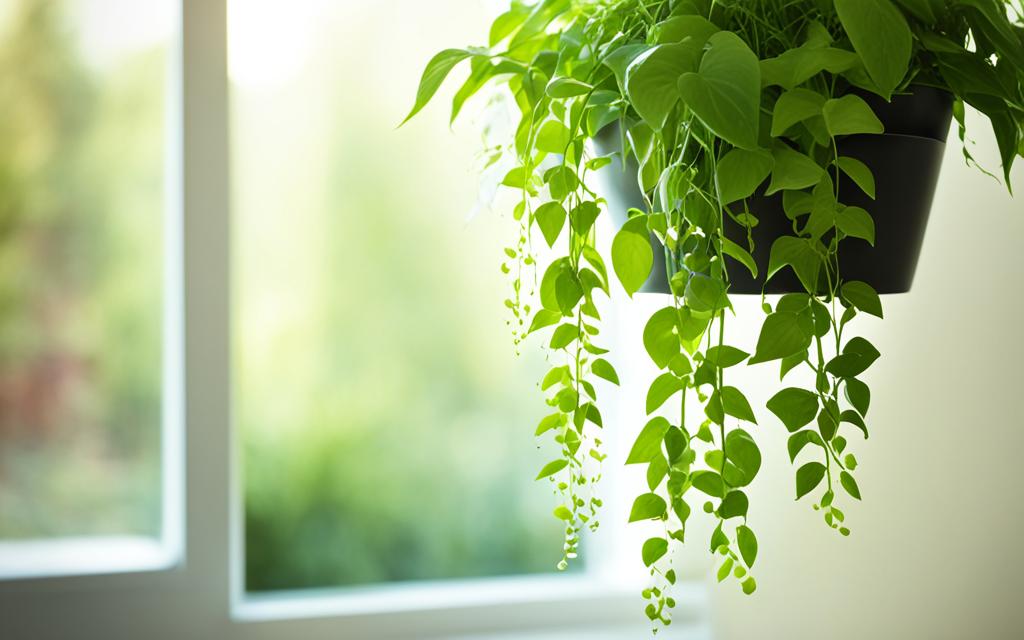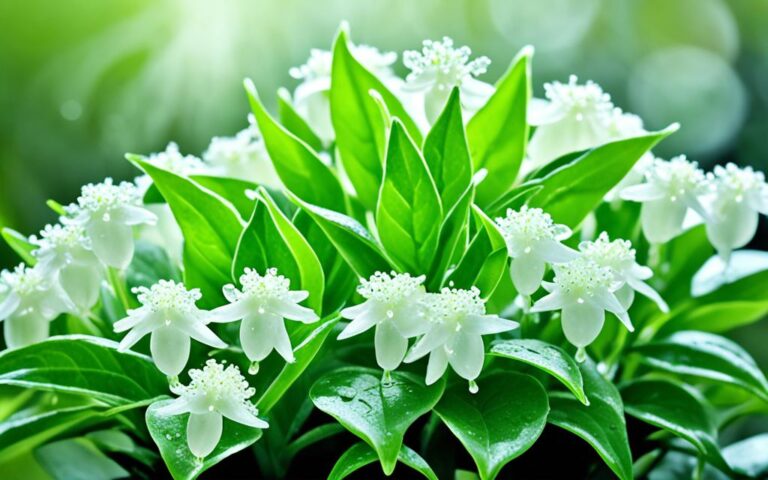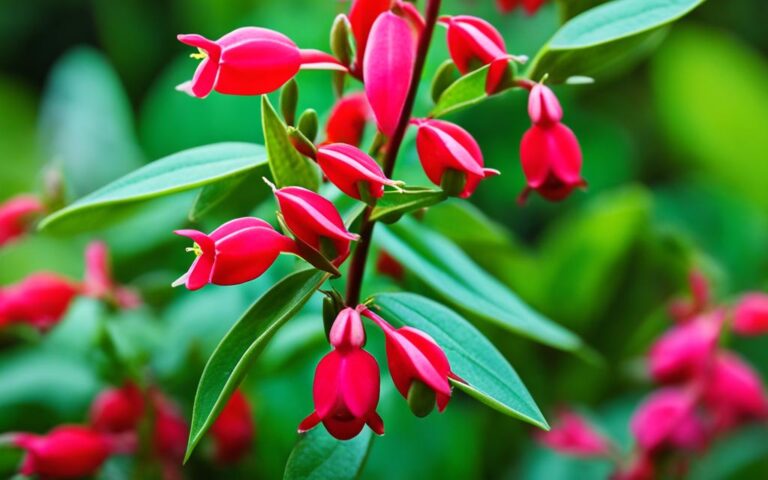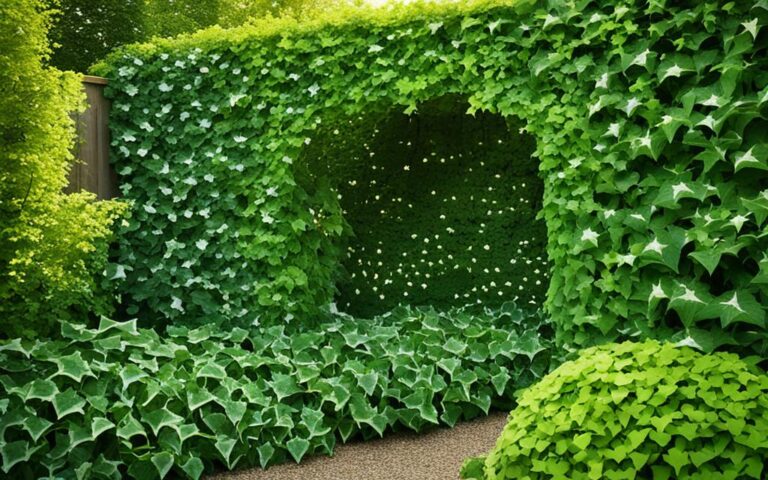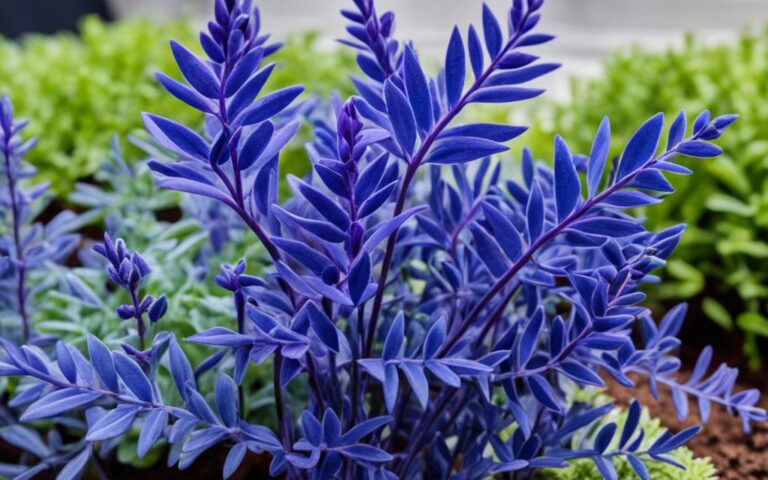Friendship Plant: Care Guide for This Charming Houseplant
Did you know the friendship plant, also called Pilea involucrata or Chinese money plant, can grow up to 12 inches tall? Yet, it usually stays around 6 inches. This plant is loved for its beautiful leaves and easy care.
It gets its name from quickly growing new roots from cuttings. This lets gardeners share it with friends and family easily. It’s perfect for anyone, whether you’re new to plants or have been gardening for years.
Key Takeaways:
- The friendship plant, or Pilea involucrata, is a charming and low-maintenance houseplant
- It can grow up to 12 inches (31 cm) in height, though typically reaching 6 inches (15 cm)
- The plant’s name comes from its ability to easily propagate through cuttings, allowing gardeners to share it with others
- Friendship plants require partial sun, consistent humidity, and moderate temperatures for optimal growth
- With proper care, this plant can even reward its caretakers with delicate pink flowers
Introduction to the Friendship Plant
The pilea involucrata, also known as the friendship plant, is a beautiful houseplant. It has textured leaves with bronze and silver metallic colorations. It’s often mixed up with pilea mollis, but they are different species. The pilea involucrata is loved for being easy to care for and spreading quickly.
Importance and Popularity
In recent years, the friendship plant has become very popular. People love its look and how easy it is to take care of. It can grow well in many conditions and easily makes new plants to share with others. It’s perfect for terrariums and safe for pets too.
Interesting Facts
- The pilea involucrata, or friendship plant, comes from Central and South America. It thrives in tropical forests.
- With the right care, it can bloom with pale pink flowers, making it even more charming.
- Its name comes from being passed from person to person, starting in Yunnan, China, and moving to Europe.
- The pilea peperomioides, a relative, was first found by George Forrest in the early 1900s. It was rediscovered in 1945 by a Norwegian missionary.
The friendship plant is loved for its beauty, simplicity, and interesting story. It’s becoming a favorite among houseplants.
Species and Varieties
The friendship plant, known as Pilea involucrata, is part of the Pilea genus with hundreds of species. Pilea involucrata is a popular choice for indoor plants. There are many other Pilea species and varieties to explore.
Common Species and Cultivars
The ‘Moon Valley’ variety of Pilea is well-known for its upright growth. It has deeply textured leaves with dark-red undersides, adding beauty. Pilea mollis, also known as Pilea involucrata, is another common species.
Unique Characteristics
The friendship plant stands out with its quilted, velvety leaves. These leaves have deep veins and shine in bronze and silver. This makes the Pilea a favorite among houseplants.
| Pilea Variety | Appearance | Care Difficulty |
|---|---|---|
| Pilea involucrata (Friendship Plant) | Quilted, velvety leaves with metallic colors | Medium (5 out of 10) |
| Pilea mollis (Moon Valley) | Upright growth habit, deeply textured leaves | Medium (5 out of 10) |
| Pilea peperomioides (Chinese Money Plant) | Vertical, tree-like growth, round leaves | Medium (5 out of 10) |
The Pilea genus offers many species and varieties, each unique. Whether you like the quilted leaves of Pilea involucrata or the striking colors, there’s a Pilea for you.
Anatomy of the Friendship Plant
The anatomy of the friendship plant, also known as the Pilea peperomioides, is quite interesting. These houseplants have soft, deeply wrinkled leaves that are oval-shaped and come in pairs. They can grow as trailing plants or be pruned to look bushy.
Description of Leaves, Stems, and Flowers
The leaves of the friendship plant have beautiful bronze highlights. In summer, they might produce small, blush pink flowers. The stems are strong and support the plant’s growth, letting it cascade beautifully in hanging baskets or on shelves.
Special Features
- Textured, quilted foliage that adds visual interest
- Easy propagation from stem cuttings, making it a popular choice for plant enthusiasts
- Adaptable growth habits, allowing for both trailing and bushy forms
- Striking bronze accents on the leaves, adding a unique touch to the plant’s appearance
The anatomy of the friendship plant shows its charm and versatility. It’s a favorite in many homes and gardens. Its unique features, like crinkled leaves and delicate flowers, make it a standout houseplant.
Ideal Growing Conditions
The Friendship Plant, also known as Pilea involucrata, is easy to care for. It needs a few things to do well: lots of light, steady humidity, and soil that’s always moist.
This plant needs 6-8 hours of light each day. It can handle some direct sun but too much can burn its leaves. Putting it near a north- or east-facing window is perfect for the right amount of light.
Keeping the right humidity is key for the Friendship Plant. It loves a humid environment, like its home in Central and South America. You can use a pebble tray, mist the leaves, or keep it in a humid spot like a bathroom or kitchen.
The plant likes its soil to be moist but not soaked. It does best in temperatures between 65-75°F (18-23°C). Keep it away from heaters or drafty spots. With the right light, humidity, and temperature, it will grow well and show off its unique leaves.
Propagating the Friendship Plant is easy, making it popular among gardeners. You can grow new plants from cuttings or offsets. This makes it known as “The Friendship Plant.” With the right care, you can enjoy its beauty and ease of maintenance.
Lighting Requirements
The friendship plant, also known as the Pilea involucrata, loves bright, indirect light. These plants come from the rainforests of Central and South America. They grow on the forest floor, getting dappled sunlight through the trees.
For the best light, put your friendship plant near a window that gets bright, indirect light. This means a south- or west-facing window is perfect. But, don’t put it in direct sunlight, as it can burn the leaves.
Good lighting is key for the friendship plant’s health and flowers. It stops leaf damage, makes the leaves strong, and helps it bloom pink flowers. Look for signs like bright green leaves and new buds to know it’s getting enough light.
If your home doesn’t get enough natural light, think about using a grow light. LED grow lights, like the Monios-L model, give a wide range of light that plants need. Just make sure the light is at the right distance from the plant.
With the right lighting, your friendship plant will do great and look beautiful.
Temperature and Humidity Needs
The friendship plant loves a warm and humid home. It does best in certain temperatures and humidity levels. Knowing what it likes is key to keeping it healthy and happy.
Ideal Temperature Range
This plant likes temperatures between 65 and 75 degrees Fahrenheit. That’s about 18 to 23 degrees Celsius. Keep it indoors to make sure it stays in this sweet spot.
If you have it outside, bring it inside when it gets colder than 60 degrees Fahrenheit. This keeps it safe from the cold.
Humidity Preferences
- The friendship plant does well in humidity levels between 50% and 70%.
- To keep the air moist, use a pebble tray, a humidifier, or mist the leaves often.
- Check humidity with a hygrometer to keep your plant happy.
- Don’t put the plant where it’s dry, like near air conditioning units.
Give your friendship plant the right temperature and humidity, and it will grow well and look great in your home.
“Maintaining the right temperature and humidity levels is crucial for the friendship plant to thrive and flourish in your indoor garden.”
Soil Needs and pH Levels
The friendship plant loves soil that’s rich in nutrients but drains well. A mix of compost, perlite, and coco coir works great. This blend keeps the soil light and airy, preventing it from drying out too fast.
For the soil requirements for friendship plant, the best pH level is between 6.0 and 7.0. This is slightly acidic to neutral. It helps the plant get the nutrients it needs for healthy growth and bright leaves.
- Nutrient-rich, well-draining soil is key for the friendship plant.
- A mix of compost, perlite, and coco coir is perfect for the soil.
- The optimal pH for friendship plant is between 6.0 and 7.0 for good nutrient uptake.
- Checking and adjusting the soil pH regularly is important for the best growth.
By giving the friendship plant the right soil requirements and pH levels, gardeners help it grow well. This makes the plant’s beautiful leaves stand out, adding to any indoor or outdoor area.
Watering the Friendship Plant
The Pilea involucrata, or friendship plant, is a lovely houseplant that needs regular watering. But, it’s crucial to be careful not to overwater. Overwatering can cause the soil to become too wet and might lead to root rot. To keep your friendship plant healthy and content, follow these watering tips:
- Water the plant regularly, about once a week, keeping the soil consistently moist but not waterlogged.
- Check the soil by sticking your finger into the potting mix. If the top inch or two feels dry, it’s time to water.
- During the growing season, you may need to water more often, as the plant grows and loses more moisture.
- In the winter months, when growth slows, cut back on watering and let the soil dry out a bit between waterings.
- Always make sure any excess water drains well from the pot after watering, as the friendship plant doesn’t like standing water.
By following these watering requirements for friendship plant, you can ensure your Pilea stays healthy and happy. The main thing is to keep the soil moist but not too wet.
“Consistent moisture is the key to a happy, healthy friendship plant. Avoid letting the soil dry out completely or allowing it to become waterlogged.”
Propagation Methods
The friendship plant, or Pilea involucrata, is easy to spread and loved for its charm. It thrives from stem cuttings, making it perfect for those who love plants. This method lets you grow more plants or share your gardening joy with others.
Growing from Cuttings
To start, pick a healthy stem that’s 3-4 inches long with many leaves. Use a rooting hormone on the cut end to help roots grow strong. Plant the cutting in moist, well-draining soil and cover it with a plastic bag to keep it humid.
Soon, you’ll see new roots. When the roots are an inch long, move the plant to its own pot. Use rich, loamy soil. This way, you can easily propagate friendship plants and share them with loved ones.
For best results, propagate in spring or early summer when the plant is active. With proper care, your growing friendship plant from cuttings will flourish. It will bring vibrant colors and a lovely look to your space.
| Propagation Method | Success Rate | Time to Root | Transplanting |
|---|---|---|---|
| Stem Cuttings | High | 1-2 weeks | When roots are 1 inch long |
| Division of Offshoots | Moderate | 1-2 weeks | When offshoots have established roots |
| Leaf Cuttings | Low | 1-2 weeks | When roots are 1 inch long |
For successful propagation of friendship plants, keep them in bright, indirect light and warm spots. Also, maintain consistent humidity. With a bit of care, you can grow your own collection of these lovely plants.
Care and Maintenance
The Pilea peperomioides, also known as the Friendship Plant, is a lovely and simple houseplant. It can add a bit of nature to any room. With the right care, this plant can flourish and spread its “friendship” through propagation. Let’s look at some key tips to keep your Friendship Plant healthy and happy.
Pruning and Training Techniques
Pilea friendship plants are small and grow at a moderate pace. They don’t need frequent repotting. Plan to repot the plant every two years as it grows, reaching full size in three to five years. Repot when the plant’s roots start showing through the drainage holes.
To keep your plant neat, trim off the top tips. These cuttings will root well, so don’t throw them away. Share them with friends or pot them up to grow more Friendship Plants. Using the right pruning and training methods will help your Pilea look great.
| Repotting Frequency | Pruning Techniques | Propagation |
|---|---|---|
| Every 2 years as the plant matures | Pinch off growing tips to maintain a compact shape | Cuttings root easily, great for sharing with friends |
By following these care tips, your Friendship Plant will flourish and spread joy in your space. With a bit of care, this houseplant will reward you with its lush foliage and the chance to share its beauty with others.
Common Pests and Diseases
Friendship Plants (Pilea involucrata) are usually easy to care for and don’t get many pests. But, they can face problems if their environment isn’t right. Let’s look at the pests and diseases they might get and how to handle them.
Overwatering can cause yellow leaves, wilting, and root rot. Underwatering makes leaves droop and turn dry or crispy. It’s important to water them right to keep them healthy.
Not enough light can make these plants grow long and have pale leaves. They need some indirect sunlight to do well. Also, if the temperature is off, leaves can turn brown and wilt. So, keeping the right temperature is key.
- Nutrient deficiency can lead to yellowing or discolored leaves and stunted growth.
- Pest infestations, such as spider mites and aphids, can leave behind yellow spots or webbing on the plant.
- Diseases like fungal infections and bacterial leaf spot can cause mold, rot, or unusual spots on the leaves and stems.
To keep pests and diseases away, use an Integrated Pest Management (IPM) plan. This means preventing problems, catching them early, and using organic and chemical controls. Check your plant often, keep new plants in quarantine, and use clean soil to lower the chance of pests.
| Pest/Disease | Symptoms | Management Strategies |
|---|---|---|
| Spider Mites | Tiny red or green pests, webbing on leaves | Neem oil, increasing humidity |
| Scale Insects | Brown or white bumps on leaves and stems, sooty mold | Pruning, introducing predators |
| Fungus Gnats | Moist soil, small flies around the plant | Diatomaceous earth, predatory mites |
| Mealybugs | White, waxy substance on leaves and stems | Rubbing alcohol, systemic insecticides |
| Aphids | Distorted growth, yellowing leaves | Insecticidal soaps, neem oil |
By watching closely and acting fast, you can keep your Friendship Plants healthy and looking great.
Fertilizing the Friendship Plant
The Friendship Plant, also known as the Chinese Money Plant or Pilea peperomioides, doesn’t need much to stay happy. Feed it a balanced liquid fertilizer, diluted to half strength, once a month from April to October. This keeps it thriving.
When it’s winter and the plant grows less, don’t give it any fertilizer. This stops over-fertilizing, which can cause leaf browning and stunted growth.
This plant does well with a balanced diet of nitrogen, phosphorus, and potassium. It also needs micronutrients. Always follow the fertilizer instructions and choose organic options to keep your plant safe.
| Fertilizer Type | Application Frequency | Dilution |
|---|---|---|
| Liquid | Every 4-6 weeks during growing season | Dilute to 1/2 strength |
| Granular | Every 2-3 months during growing season | Follow product instructions |
| Slow-release | Apply in spring and replenish as needed | N/A |
By giving the Friendship Plant the right fertilizing requirements, it will stay vibrant and healthy. It will spread its charm all over your home.
Conclusion
The Pilea Aquamarine, or Friendship Plant, is a lovely and simple houseplant. It brightens any indoor area with its vibrant green leaves and unique texture. With the right care, like giving it bright, indirect light and the right temperature, your plant will flourish.
This plant is great for sharing with others because it easily grows new plants, or pups. This makes caring for the friendship plant even more rewarding. It’s perfect for both new and experienced gardeners, adding beauty and joy to your home.
Let the friendship plant add nature and community to your space. With the right care, it will keep growing and make everyone happy.
